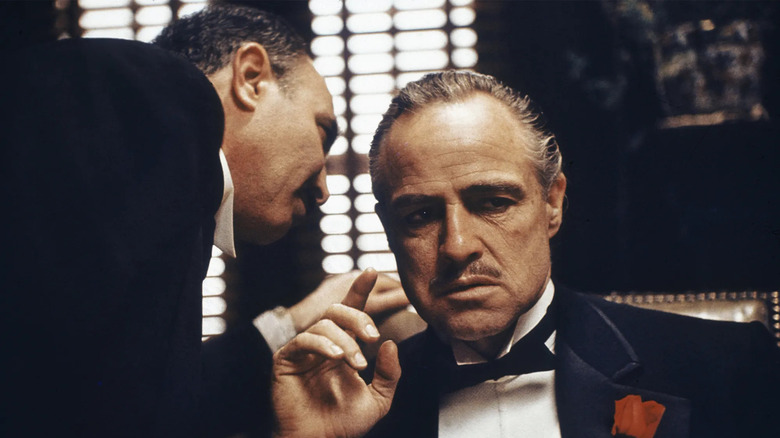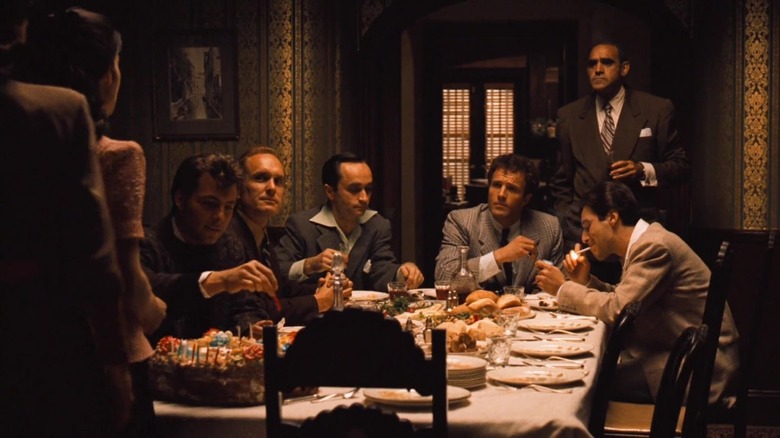Francis Ford Coppola Had To Cut Marlon Brando's The Godfather Part II Cameo
After the financial and critical success of "The Godfather," audiences eagerly awaited the sequel. The original author and screenwriter, Mario Puzo, had begun the script before the first film was released (via Oscars). In "Godfather: The Intimate Francis Ford Coppola" by Gene Phillips, Puzo relayed his idea for the sequel:
"I thought it would be interesting to juxtapose the ascension of the family under Vito Corleone with the decline of the family under his son Michael ... I had always wanted to write a screenplay that told the story of a father and a son at the same age. They were both in their 30s and I would integrate the two stories ... In order not to merely make 'Godfather I' over again, I gave 'Godfather II' this double structure by extending the story in both the past and in the present."
Director Francis Ford Coppola petitioned Marlon Brando with a letter to play the role of young Vito Corleone, despite his age of 49. The role famously went to a young Robert De Niro, who would go on to win the Oscar for his pensive performance that incorporated Brando's unique mannerisms while remaining very much his own. Brando did agree to return for a flashback sequence at the end that depicted the Corleone siblings gathering for Vito's birthday celebration, culminating in a dialogue between him and Al Pacino as prodigal son Michael.
However, Brando did not show up on the day of filming as a form of protest against Paramount's mistreatment and poor pay. To orchestrate the ending scene of "The Godfather Part II," Coppola explained (via Film School Rejects):
"We made the deals with all these actors. Of course, a lot of the actors were mad at us because the first movie was cheap and nobody got paid a lot of money."
Brando's unexpected absence forced Coppola to pivot and tweak the ending, but it ends up working even better to communicate the film's theme of father and son relationships.
Brando's abscence adds to the scene
In the final version of the ending, Michael Corleone sits outside on a breezy autumn day reflecting. On December 7, 1941, the Corleone siblings gather for Vito's birthday celebration and discuss the Pearl Harbor bombings that occurred earlier that day. Michael announces he has quit college and joined the Marines to fight for the Allies in World War II.
Sonny explodes in a fit of rage, calling those who enlist saps because "they risk their lives for strangers" and accuses Michael of breaking his father's heart on his birthday. Tom is annoyed because Vito pulled strings for his deferment and has big plans for his future. Familial loyalty means everything to Sonny and Tom, not national loyalty. Michael insists he has his own plans, refusing to be the family puppet. The siblings hear Vito arrive and follow the patriarch off-screen while singing "For He's a Jolly Good Fellow." Michael is left by himself, brooding over his cigarette.
The solitary shot of Michael encapsulates his independence and separation from the rest of the family. Michael abides by his own moral credo and rules, which allows him to become such a cold, ruthless leader — murdering his own brother, isolating his wife from his children, and pursuing wealth and power with a quiet ferocity. The image elegantly contrasts the old Don versus the new: Vito, who puts his family before himself and his business, is lovingly greeted by his adoring children, whereas Michael eviscerates all his relationships. In "The Godfather: Part III," Michael's final breath is taken alone, except for a small dog.
Although Vito is absent, his presence weighs heavily over the Corleone siblings. It is more fitting that Michael never speaks with Vito, as it shows their clear divide. Michael refuses to conform to Vito's expectations, even when stepping into the role of leader, while Sonny and Tom are blindly devoted to their father. Marlon Brando's cameo certainly would have be exciting to see, but the scene ends up being far more poetic without him.

